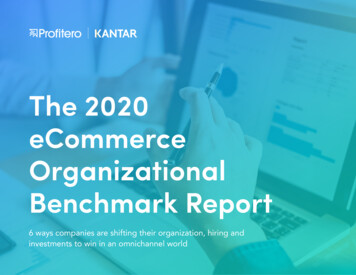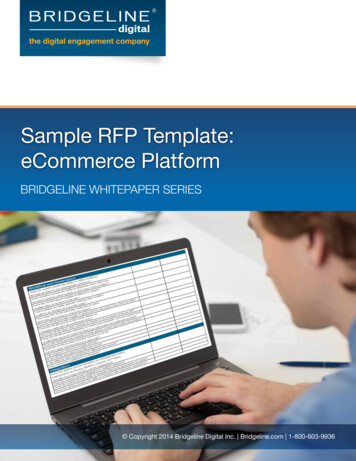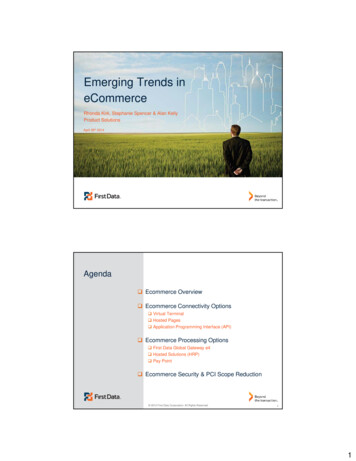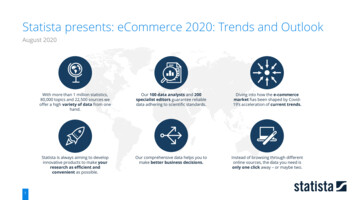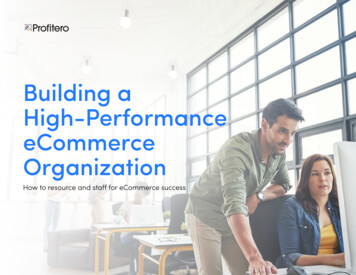
Transcription
Building aHigh-PerformanceeCommerceOrganizationHow to resource and staff for eCommerce success
What you’ll learn: The importance of culture and C-level buy-in inorganizational success Where eCommerce should report What makes a successful digital commerce leader How to determine, allocate and grow dedicated While hard to imagine nowadays, it wasn’t too long ago when companies hadnobody dedicated to eCommerce. This was pretty much the case across the CPGindustry. In fact, if you were working on eCommerce at all, you were designatedresponsibility for it typically alongside other channels.The title of VP or Director of “alternative channels” was not uncommon 10 yearsago. This role covered a mix of small and emerging channels—such as club stores,discounters, military and eCommerce—sectors that really didn’t “fit” anywhereelse or fit the mold of traditional retail models.headcountIt’s funny when you think about the complexity and nuances of these four wildlyBalancing in-sourcing versus outsourcing todifferent the skill set and path to success is for eCommerce versus something likedifferent channels lumped under the guise of “alternative.” Just consider howbrokers, agencies and consultantsmilitary, or even club or discount. Yet that was the level of attention and focusCritical workstreams, and common roles andWe’ve come a long way as an industry—from fundamentally one personresponsibilities needed to succeedthese channels were given back then. The result: very little potential was realized.supporting the entire eCommerce channel as a quarter of their time to companiesnow having dedicated teams of highly specialized people working on a full-timebasis. There’s been an incredible evolution in terms of eCommerce specializationand dedication in a few short years. Still, these dedicated eCommerce specialistsare supporting only a fraction of what actually needs to be done.The industry continues to grapple with questions about how to participatein and organize around eCommerce, particularly without sacrificing companyheritage or culture. Many of these issues are addressed in this paper, withProfitero providing some guidelines and benchmarks based on our research.However, some organizational issues remain a work in process. They’ll continue toevolve over time as eCommerce grows and digital becomes more pervasive.2
Prerequisites for eCommerce successThere are of course some burning organizationalquestions on nearly everyone’s mind: How big is the typical eCommerce team?13C-level and board support. There continues to beAcknowledged need for new specialization. Thisskepticism and internal resistance about eCommercemeans a dedicated and skilled professional focus byinside many companies. Without executive supportmanagement is necessary to ensure activities critical Where does it report?and acknowledgment of digital as a strategic priority,to eCommerce success aren’t slipping through the How is it structured globally?efforts could be dead in the water before they start.cracks. Optimizing search placement on retailers’ What activities are in-sourced versus outsourced?Therefore, it’s important that the top brass explicitlysites, developing and managing digital productstates from the get-go that the company is doingcontent, and analyzing channel performance and How many people are out in the field?eCommerce and going to do it well. More and more,profitability are among the roles and responsibilitiesBut none of that matters if some pre-conditions towe see CEOs becoming outspoken advocates andthat need to be covered.doing eCommerce aren’t met—that is, having thechampions of eCommerce.intangibles or prerequisites for eCommerce successright in the first place. These include:“The digitization of the whole[shopping] experience is ongoing andpermanent and we need to participatein that.”—James QuinceyCEO, The Coca-Cola CompanySource: 2018 CAGNY conference42Understanding that eCommerce success followsExpectation that everyone in the organizationa different path, and a rather unfamiliar one atall disciplines and functions will be impactedoperating with a certain level of ambiguity. This iswill have some accountability. Without a doubt,that. It’s important that companies be comfortableand involved in the transition to eCommercebecause eCommerce success can’t be measuredin some capacity. Digital is not something thatpurely based on existing metrics or traditionaljust sits adjacent to what the business alreadycriteria. Instead, high-performing organizations givedoes. Consequently, it’s vital to create awarenesseCommerce teams a bit of latitude because theirthroughout the ranks and invest in cross-functionalgoals, definition of success and pathway is usuallytraining and development to (at the very least)different than that of mature channels.establish a baseline vocabulary and communicatethe basic concepts. Ensuring everyone has a vestedinterest in seeing eCommerce succeed rather thanviewing it as internal competition or cannibalizationis critical.B U I L D I N G A H I G H - P E R F O R M A N C E E C O M M E R C E O R G A N I Z AT I O N3
“We’re up 82% so far in eCommerce in the US in thefirst half [of the year], and we’re taking our capabilitesglobal. Even though it’s dynamic and there is a lotchange [in eCommerce] . that change is opportunityfor those who are willing to take it.” —Jeff HarmeningCEO, General MillsSource: 2018 CAGNY conference
Organizing around eCommerceThere is no single universal and overarching answerfor how to organize around eCommerce. Thispaper presents some guidelines, based in part onMaturity level of brand manufacturers in organizing around eCommerce, 2017Source: Profitero survey. Scope: Globalthe findings from Profitero’s survey of 134 brandsLarger than 500M44%around the globe, proprietary research of LinkedInSmaller than 500M /professional profiles and job postings, and an30%analysis which ties sales performance to teamstructure.The good news is that it’s still early innings ofNot publicly available26%28%24%16%developing eCommerce organizations. This is7%especially true for many smaller and mid-sized10%3%brands.0%3%8%Our research shows a notable divergence in theNoviceAmateurAdvancedExpertLeaderDon’t know /level of sophistication between large and smallWe are justbeginning toorganize aroundeCommerceWe are engagingretailers in jointbusiness planning thatincludes eCommerceAll of the above,plus dedicatedeCommerceresourcesAll of the above,plus clear objectivesfor eCommerceas a distribution &marketing channelAll of the above,plus we believewe set the digitalstandard among ourpeers/competitorsprefer notcompanies: 54% of smaller CPGs (defined as 500Min sales) self-identified as “novices” orto answer“amateurs”—really just starting down the pathof organizing around eCommerce. The level of sophistication increases, however,with company size. A higher share (44%)Regardless of company size, a very small percentageof the industry considers themselves experts orleaders.of large CPGs ( 500M ) relative to smallerThe opportunity clearly exists to mold yourcompanies self-identify as “advanced.” Still, ateams—and organizations as a whole—for highfairly substantial 42% of large CPGs self-reportperformance. Consider it an ongoing quest asas novices or amateurs.eCommerce sales grow and the channel matures.B U I L D I N G A H I G H - P E R F O R M A N C E E C O M M E R C E O R G A N I Z AT I O N5
Where eCommerce reportsThere is no single “right” answer for whereeCommerce should report. It depends on yourcompany’s strategic objectives and priorities for thechannel, as well as company culture.Our data shows that eCommerce most typicallyreports into Sales: This was the case for about 75% ofthe CPG companies we surveyed. The other 25% ofcompanies have it reporting into Marketing.So, if the question is: Where does it report?The answer is: Sales.But if the question is: Where should it report? Thenit all depends on a company’s culture and definingobjectives up front.An argument certainly can be made for reporting intoeither Sales or Marketing:Reporting into Sales.Reporting into Marketing.If your objective is primarily to generate volume,If the company’s priority is building or protectingAn increasingly common approach is aligninggain market share, and get eCommerce on a pathbrand equity or driving awareness and influence, thenSales and Marketing by establishing a dotted-lineto profitability, then it should report into Sales. SalesMarketing might be the best place for eCommercereporting relationship between eCommerce and thewill give disproportionate weight to commercialto report. This will allow for synergies to be drawnfunction to which it does not directly report. That is,decisions about distribution, pricing, promotion andwith other marketing disciplines, particularly in areasif eCommerce reports to Sales, establish a dotted-supply chain. The main drawback here is that you risklike digital display advertising, search optimizationline to Marketing. Likewise, when reporting intobeing under-resourced on the basis of overall channeland content marketing. Drawbacks however includeMarketing, have a dotted-line to Sales.volume (typically quite small as a proportion of totalpotentially under-emphasizing the significancecompany sales) or the channel’s profitability (or lackof supply chain, stock availability, pricing andthereof).promotion.B U I L D I N G A H I G H - P E R F O R M A N C E E C O M M E R C E O R G A N I Z AT I O N6
Balancing global & local market considerationsManaging global aspirations while accounting forSome key objectives to this type of balancedlocal considerations is often a balancing act for largeapproach:multinational brands. Wildly divergent eCommerce market dynamics in different parts of the world—e.g.,in China vs. the US vs. the UK—underscores thepresent the brand globally or manage factorsimportance of balancing global with local onlineinitiatives.that are known to drive performance. Most successful companies start by appointing anAnd they deploy an operating model or frameworkthat allows for a certain degree of freedom andlocalization based on market needs. This way, ratherYet it still provides regional teams the latitude toapply their judgment of what’s applicable at theexecutive who sets and oversees global strategy,organization design and capability deployment.It enables management to focus on globalobjectives or leading practices, e.g., how tolocal level. It also enables local market teams to learn anddiscover things that can then be shared back tomanagement and the broader organization.than steamrolling regional or country teams, localCompanies that figure out this balancing act—givingnuances are considered.their highest-potential regions autonomy and supportto lead in their respective markets—operate as highperformance eCommerce organizations.B U I L D I N G A H I G H - P E R F O R M A N C E E C O M M E R C E O R G A N I Z AT I O N7
Profile of a successful eCommerce leadereCommerce impacts every part of the organization and if left to their own way, each function willinstitution (e.g., Harvard, Wharton, et.al.).attack it from their own narrow view. As such,many companies are recognizing they need anBlue chip consultant à la McKinsey or BCG,complete with an MBA from a highly regarded Somebody who’s led eCommerce initiatives‘eCommerce czar’—i.e., someone to pull all thein a category that’s more mature, like toyspieces together and champion a holistic effortor electronics.to capitalize on this once-in-a-lifetime businessmodel shift.for the oft-needed internal selling and consensusbuilding, that is, moving the organization from thestatus quo to where you want to take the company.While any of the aforementioned profiles can provesuccessful, domain experience (i.e., CPG know-how)coupled with a passion for innovation, improving theIncreasingly, gravitas and credibility inside thecustomer experience and forging retailer partnershipscompany’s four walls is an essential prerequisitecould be a winning formula.Based on our LinkedIn research of more than100 CPG companies with sales of at least 65million, 81% now have a Head of eCommerce (VPor Director).As companies begin to prioritize eCommerce anddedicate budget to hiring, different profiles ofSample job description template—eCommerce Leadcandidates to lead the initiative often emerge: Experienced leader with deep industryEstablish corporate eCommerce channel Identify, select and deploy tools,knowledge, often someone who has come upstrategy for assigned region/businesstechnologies and capabilities thatthrough the ranks in disciplines such as salesunit/categoryenable performanceor shopper marketing, but now needs to learn Build and manage a high-performance Develop commercial playbooks foreCommerce on the job.team, including direct reports andeCommerce in areas including search,eCommerce/digital/social native (i.e., oftenindirect reports embedded on account orproduct content, promotions, and morefrom one of the FANG companies: Facebook,other teamsAmazon, Netflix, Google), someone who doesn’t Sales and P&L responsibility for pure-playeCommerce retailersnecessarily have industry knowledge, buthas a deep understanding of technologyand eCommerce.B U I L D I N G A H I G H - P E R F O R M A N C E E C O M M E R C E O R G A N I Z AT I O N8
“Let me guess? Resources in your organization areconstrained. No matter their commitment level toeCommerce as a strategic priority, all organizationsare selective by necessity about where and how toallocate people and funds. To succeed, though, youreCommerce staffing model cannot be a static one—albeit when first starting off, it could be small. It mustbe dynamic and fluid, and expected to evolve overtime, dictated by volume growth and channel maturity.” —Keith AndersonSVP Strategy & Insights, ProfiteroP R O D U C T C O N T E N T: PA C K A G I N G F O R T H E D I G I TA L S H E L F9
Dedicated versus designated resourcesFor
CEO, The Coca-Cola Company Acknowledged need for new specialization. This means a dedicated and skilled professional focus by management is necessary to ensure activities critical to eCommerce success aren’t slipping through the cracks. Optimizing search placement on retailers’ sites, developing and managing digital product



